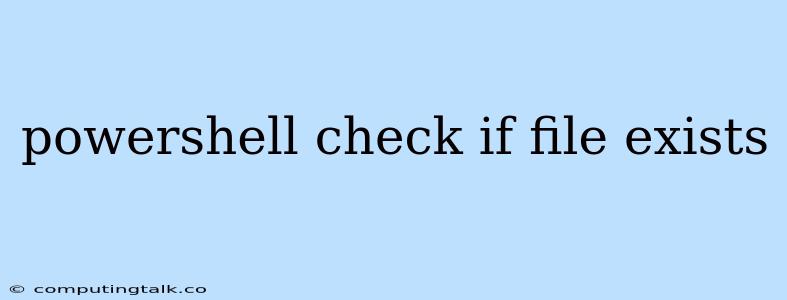The PowerShell command line is a powerful tool for managing and automating tasks on Windows systems. One common task is checking if a file exists. This is essential for various scenarios, such as verifying the presence of a file before processing it, ensuring that a specific file is available for use, or triggering actions based on the file's existence. This article will provide a comprehensive guide to checking if a file exists using PowerShell.
The Test-Path Cmdlet
The PowerShell cmdlet Test-Path is specifically designed to determine if a file or directory exists. It takes a single argument, the path to the file or directory you want to check.
Here's how to use Test-Path to check for a file:
Test-Path "C:\MyFolder\myfile.txt"
This command will return True if the file myfile.txt exists in the C:\MyFolder directory, and False otherwise.
Example:
Let's assume you want to check if a configuration file named config.xml exists in the current directory. You can use the following command:
Test-Path ".\config.xml"
If the file exists, the command will output True. If not, it will output False.
Using Variables for Flexibility
You can make your scripts more flexible by using variables to store file paths. This allows you to easily change the file you're checking without modifying the code itself.
Example:
$filename = "C:\MyFolder\myfile.txt"
Test-Path $filename
In this example, the variable $filename stores the path to the file. You can easily change the value of $filename to check for different files.
Checking for Directories
The Test-Path cmdlet can also be used to check if a directory exists. Simply provide the path to the directory as the argument.
Example:
Test-Path "C:\MyFolder"
This command will return True if the directory C:\MyFolder exists, and False otherwise.
Integrating with Other Cmdlets
You can combine Test-Path with other PowerShell cmdlets to perform more complex tasks. For instance, you can use it in conditional statements to execute code only if a file exists.
Example:
if (Test-Path "C:\MyFolder\myfile.txt") {
# File exists, perform some action
Write-Host "File found!"
} else {
# File does not exist, perform another action
Write-Host "File not found!"
}
In this example, the code checks if the file myfile.txt exists. If it does, it outputs "File found!". Otherwise, it outputs "File not found!".
Advanced Techniques
PowerShell offers advanced techniques for checking file existence:
-
Wildcards: You can use wildcards like
*and?to check for multiple files matching a pattern.Test-Path "C:\MyFolder\*.txt"This command checks for any file with the
.txtextension in theC:\MyFolderdirectory. -
Logical Operators: You can combine multiple
Test-Pathcommands using logical operators like-and,-or, and-notto create more complex checks.Test-Path "C:\MyFolder\myfile.txt" -and Test-Path "C:\MyFolder\config.xml"This command checks if both
myfile.txtandconfig.xmlexist in theC:\MyFolderdirectory. -
Error Handling: You can handle errors that might occur during file existence checks using
try...catchblocks.try { Test-Path "C:\MyFolder\myfile.txt" } catch { Write-Host "An error occurred during file existence check." }
Conclusion
Checking if a file exists is a common task when working with files in PowerShell. The Test-Path cmdlet provides a simple and reliable way to determine file existence. By incorporating it into your scripts, you can enhance the reliability and efficiency of your automation tasks. This article has explored various techniques for checking file existence, from basic usage to advanced scenarios. Using these techniques, you can efficiently determine the presence of files in your Windows environment and perform relevant actions accordingly. Remember to use variables for flexibility, combine Test-Path with other cmdlets, and consider using wildcards and logical operators for complex checks.
